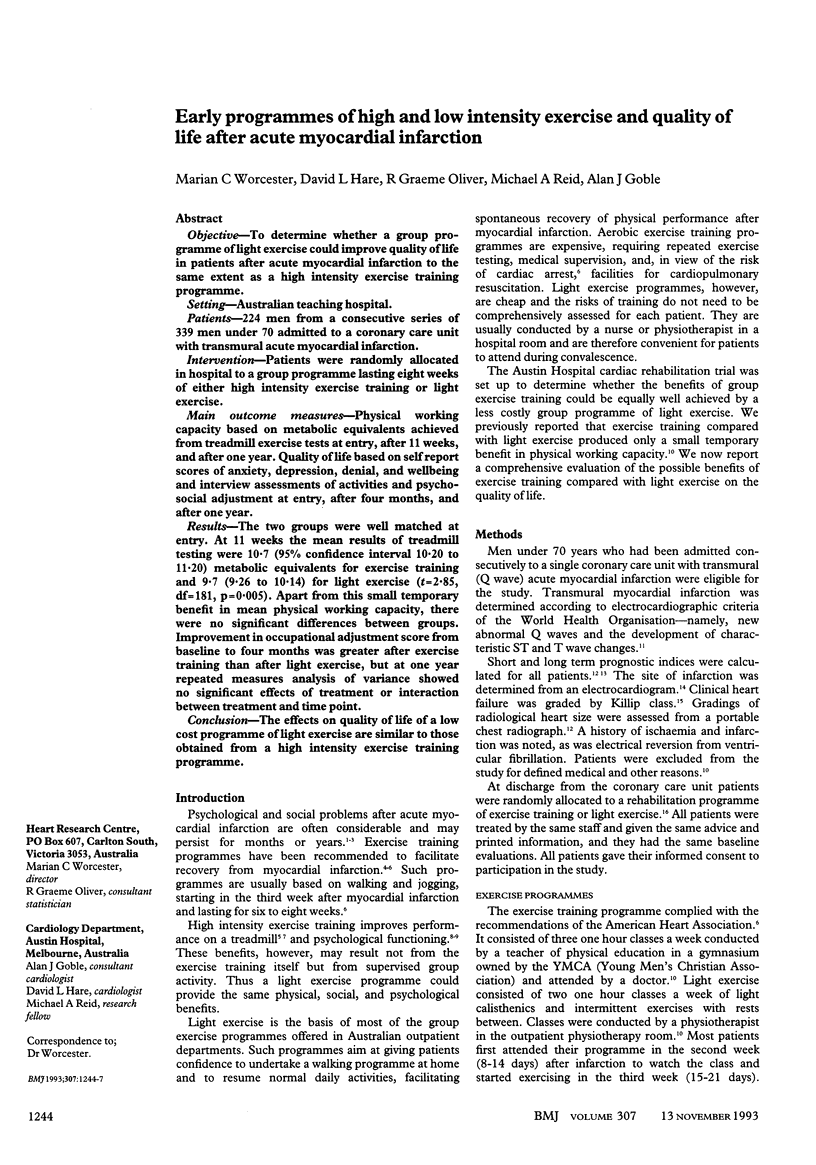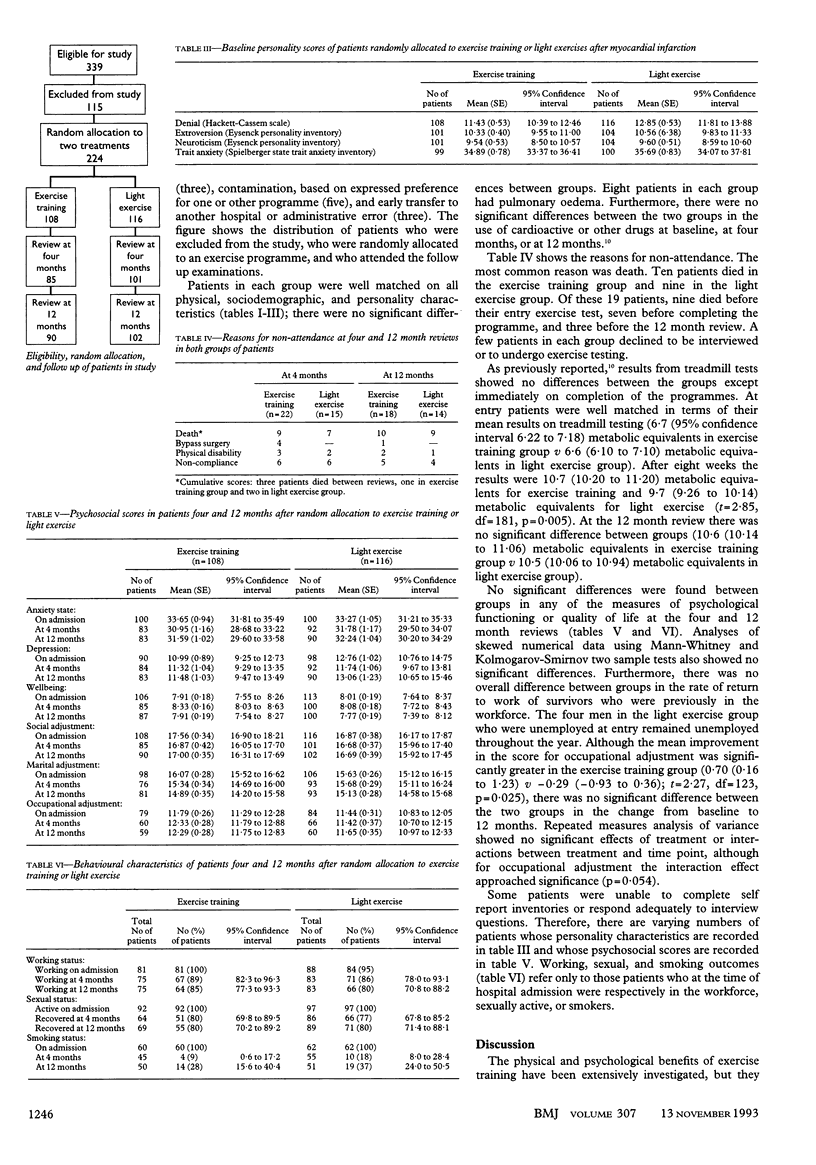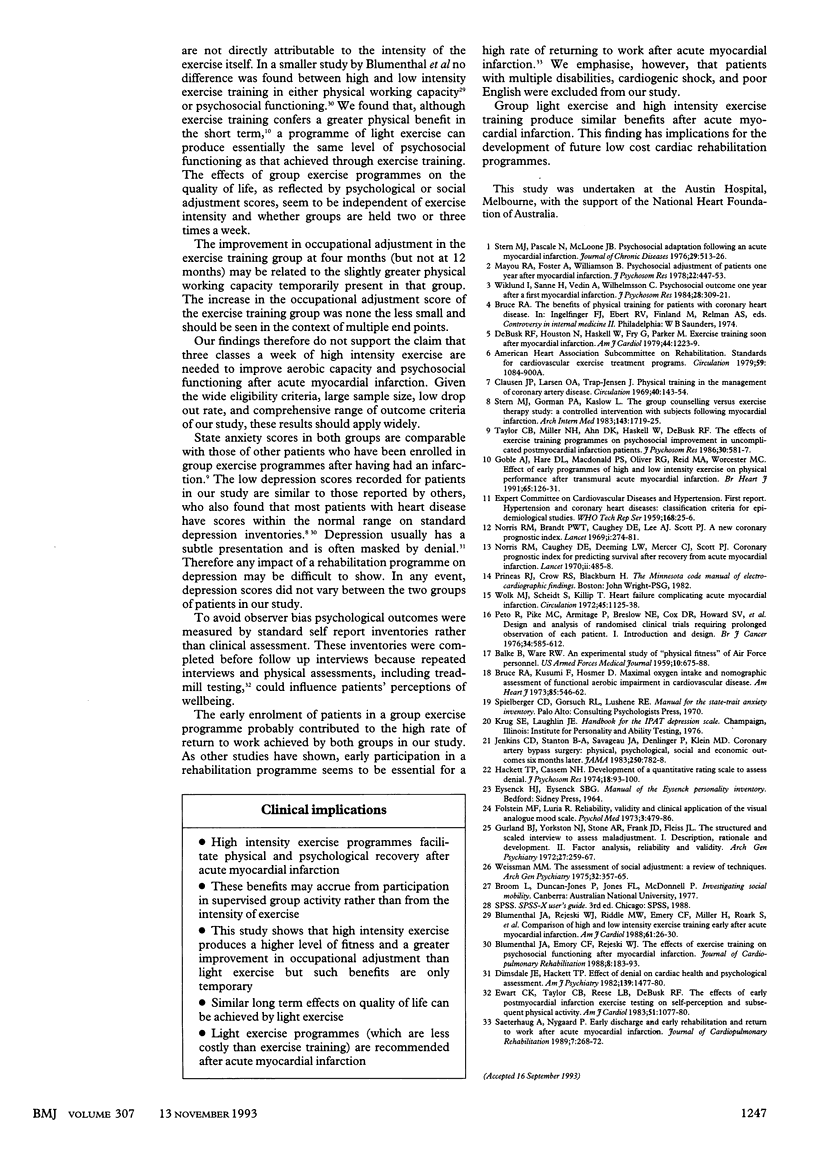Abstract
OBJECTIVE--To determine whether a group programme of light exercise could improve quality of life in patients after acute myocardial infarction to the same extent as a high intensity exercise training programme. SETTING--Australian teaching hospital. PATIENTS--224 men from a consecutive series of 339 men under 70 admitted to a coronary care unit with transmural acute myocardial infarction. INTERVENTION--Patients were randomly allocated in hospital to a group programme lasting eight weeks of either high intensity exercise training or light exercise. MAIN OUTCOME MEASURES--Physical working capacity based on metabolic equivalents achieved from treadmill exercise tests at entry, after 11 weeks, and after one year. Quality of life based on self report scores of anxiety, depression, denial, and wellbeing and interview assessments of activities and psychosocial adjustment at entry, after four months, and after one year. RESULTS--The two groups were well matched at entry. At 11 weeks the mean results of treadmill testing were 10.7 (95% confidence interval 10.20 to 11.20) metabolic equivalents for exercise training and 9.7 (9.26 to 10.14) for light exercise (t = 2.85, df = 181, p = 0.005). Apart from this small temporary benefit in mean physical working capacity, there were no significant differences between groups. Improvement in occupational adjustment score from baseline to four months was greater after exercise training than after light exercise, but at one year repeated measures analysis of variance showed no significant effects of treatment or interaction between treatment and time point. CONCLUSION--The effects on quality of life of a low cost programme of light exercise are similar to those obtained from a high intensity exercise training programme.
Full text
PDF



Selected References
These references are in PubMed. This may not be the complete list of references from this article.
- BALKE B., WARE R. W. An experimental study of physical fitness of Air Force personnel. U S Armed Forces Med J. 1959 Jun;10(6):675–688. [PubMed] [Google Scholar]
- Bernstein R. A., Gieffer E. E., Rimm A. A. Gallbladder disease(-)I. Assessment of validity and reliability of data derived from a questionnaire. A study of 62,739 weight-conscious women. J Chronic Dis. 1976 Jan;29(1):51–58. doi: 10.1016/0021-9681(76)90067-9. [DOI] [PubMed] [Google Scholar]
- Blumenthal J. A., Rejeski W. J., Walsh-Riddle M., Emery C. F., Miller H., Roark S., Ribisl P. M., Morris P. B., Brubaker P., Williams R. S. Comparison of high- and low-intensity exercise training early after acute myocardial infarction. Am J Cardiol. 1988 Jan 1;61(1):26–30. doi: 10.1016/0002-9149(88)91298-2. [DOI] [PubMed] [Google Scholar]
- Bruce R. A., Kusumi F., Hosmer D. Maximal oxygen intake and nomographic assessment of functional aerobic impairment in cardiovascular disease. Am Heart J. 1973 Apr;85(4):546–562. doi: 10.1016/0002-8703(73)90502-4. [DOI] [PubMed] [Google Scholar]
- Clausen J. P., Larsen O. A., Trap-Jensen J. Physical training in the management of coronary artery disease. Circulation. 1969 Aug;40(2):143–154. doi: 10.1161/01.cir.40.2.143. [DOI] [PubMed] [Google Scholar]
- DeBusk R. F., Houston N., Haskell W., Fry G., Parker M. Exercise training soon after myocardial infarction. Am J Cardiol. 1979 Dec;44(7):1223–1229. doi: 10.1016/0002-9149(79)90433-8. [DOI] [PubMed] [Google Scholar]
- Dimsdale J. E., Hackett T. P. Effect of denial on cardiac health and psychological assessment. Am J Psychiatry. 1982 Nov;139(11):1477–1480. doi: 10.1176/ajp.139.11.1477. [DOI] [PubMed] [Google Scholar]
- Folstein M. F., Luria R. Reliability, validity, and clinical application of the Visual Analogue Mood Scale. Psychol Med. 1973 Nov;3(4):479–486. doi: 10.1017/s0033291700054283. [DOI] [PubMed] [Google Scholar]
- Goble A. J., Hare D. L., Macdonald P. S., Oliver R. G., Reid M. A., Worcester M. C. Effect of early programmes of high and low intensity exercise on physical performance after transmural acute myocardial infarction. Br Heart J. 1991 Mar;65(3):126–131. doi: 10.1136/hrt.65.3.126. [DOI] [PMC free article] [PubMed] [Google Scholar]
- Gurland B. J., Yorkston N. J., Stone A. R., Frank J. D., Fleiss J. L. The Structured and Scaled Interview to Assess Maladjustment (SSIAM). I. Description, rationale, and development. Arch Gen Psychiatry. 1972 Aug;27(2):259–264. doi: 10.1001/archpsyc.1972.01750260101017. [DOI] [PubMed] [Google Scholar]
- Hackett T. P., Cassem N. H. Development of a quantitative rating scale to assess denial. J Psychosom Res. 1974 Apr;18(2):93–100. doi: 10.1016/0022-3999(74)90072-5. [DOI] [PubMed] [Google Scholar]
- Jenkins C. D., Stanton B. A., Savageau J. A., Denlinger P., Klein M. D. Coronary artery bypass surgery. Physical, psychological, social, and economic outcomes six months later. JAMA. 1983 Aug 12;250(6):782–788. doi: 10.1001/jama.250.6.782. [DOI] [PubMed] [Google Scholar]
- Mayou R., Foster A., Williamson B. Psychosocial adjustment in patients one year after myocardial infarction. J Psychosom Res. 1978;22(5):447–453. doi: 10.1016/0022-3999(78)90068-5. [DOI] [PubMed] [Google Scholar]
- Norris R. M., Brandt P. W., Caughey D. E., Lee A. J., Scott P. J. A new coronary prognostic index. Lancet. 1969 Feb 8;1(7589):274–278. doi: 10.1016/s0140-6736(69)91035-6. [DOI] [PubMed] [Google Scholar]
- Norris R. M., Caughey D. E., Deeming L. W., Mercer C. J., Scott P. J. Coronary prognostic index for predicting survival after recovery from acute myocardial infarction. Lancet. 1970 Sep 5;2(7671):485–487. doi: 10.1016/s0140-6736(70)90110-8. [DOI] [PubMed] [Google Scholar]
- Peto R., Pike M. C., Armitage P., Breslow N. E., Cox D. R., Howard S. V., Mantel N., McPherson K., Peto J., Smith P. G. Design and analysis of randomized clinical trials requiring prolonged observation of each patient. I. Introduction and design. Br J Cancer. 1976 Dec;34(6):585–612. doi: 10.1038/bjc.1976.220. [DOI] [PMC free article] [PubMed] [Google Scholar]
- Stern M. J., Gorman P. A., Kaslow L. The group counseling v exercise therapy study. A controlled intervention with subjects following myocardial infarction. Arch Intern Med. 1983 Sep;143(9):1719–1725. [PubMed] [Google Scholar]
- Taylor C. B., Houston-Miller N., Ahn D. K., Haskell W., DeBusk R. F. The effects of exercise training programs on psychosocial improvement in uncomplicated postmyocardial infarction patients. J Psychosom Res. 1986;30(5):581–587. doi: 10.1016/0022-3999(86)90031-0. [DOI] [PubMed] [Google Scholar]
- Weissman M. M. The assessment of social adjustment. A review of techniques. Arch Gen Psychiatry. 1975 Mar;32(3):357–365. doi: 10.1001/archpsyc.1975.01760210091006. [DOI] [PubMed] [Google Scholar]
- Wiklund I., Sanne H., Vedin A., Wilhelmsson C. Psychosocial outcome one year after a first myocardial infarction. J Psychosom Res. 1984;28(4):309–321. doi: 10.1016/0022-3999(84)90053-9. [DOI] [PubMed] [Google Scholar]


